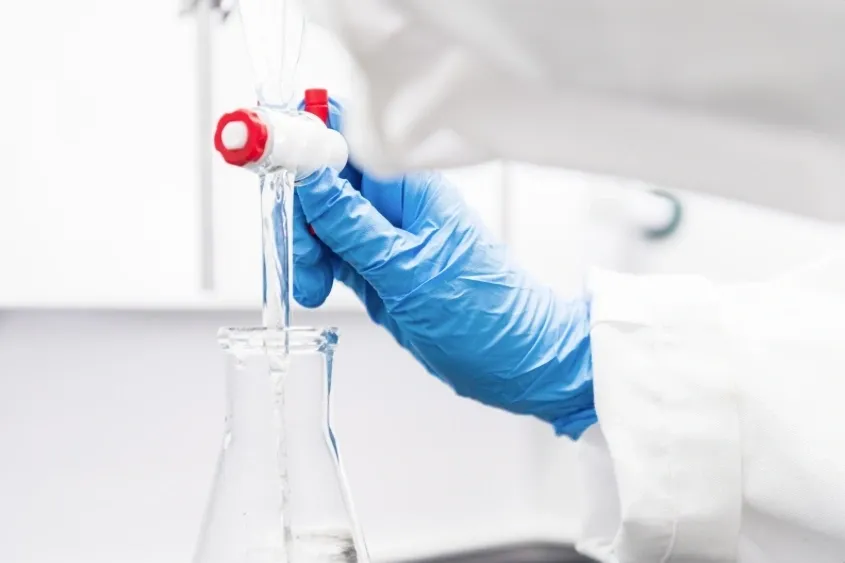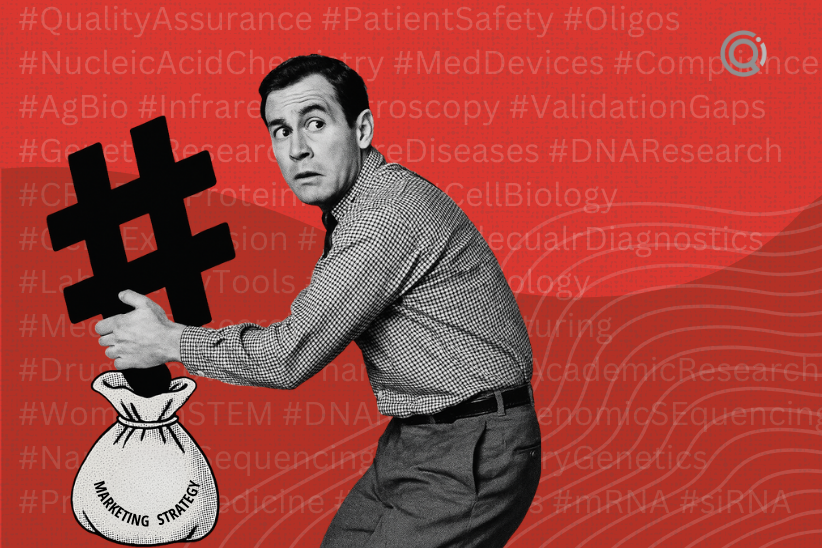Often as marketers, we spend a lot of time, energy and budget focused on generating new leads, but not nearly as much attention goes into converting them. And yet realistically, nurturing your existing leads is typically 33% less expensive than generating new leads. [1] In the Life Science industry, where the average sales cycle is long and complex, the cost advantage will likely be even more significant. So, what exactly is standing in the way of companies focusing more attention on funnel conversion?
Given the complexity of the Life Science customer journey and sales cycle, addressing the challenges in funnel conversion in this sector requires a multifaceted approach. From attracting the attention of highly specialized potential customers to navigating regulatory constraints and ensuring leads are nurtured effectively, each stage of the funnel requires tailored strategies. In this blog, we delve into the common challenges encountered in Life Science funnel conversion and offer some practical solutions to overcome them.
Understanding the Life Science funnel
Typically, the marketing and sales funnel in Life Science is divided into several stages:
- Awareness: Potential customers first become aware of the products or services your company offers.
- Interest: A lead expresses an interest in either a product or service and seeks more information. This might come in the form of a direct request or by downloading some bottom-of-the-funnel material.
- Evaluation: Prospects evaluate your products or services against their needs and compare them with competitors.
- Consideration: At this stage, prospects are seriously considering your solution and may request a proposal or engage in deeper discussions.
- Decision/Purchase: The final decision to purchase is made.
- Post-purchase/Retention: Ensuring customer satisfaction and encouraging repeat business. This is particularly important in Life Science as small quantities of reagents might be purchased to test their efficacy in an assay, so post-purchase support is crucial to ensure repeat business.
Even though the funnel has been documented as a linear process, the customer journey is anything but that and prospective customers consult multiple sources of information before making a buying decision. According to HubSpot[2], 96% of prospects do their own research before speaking with a human sales rep, and scientist customers are by nature researchers and problem-solvers, so expect them to be quite well-informed by the time they engage your sales team. It’s therefore vital to create plenty of content that allows for this research to take place and to ensure that your content marketing strategy includes an omnichannel approach, covering social media, email marketing, ads, events, digital, telemarketing, commercial (inside and regional sales) and third-party media providers, to reach potential customers through various touchpoints. Bear that in mind as we explore the common challenges faced at each stage and look at ways to address them.
Challenge 1: Generating awareness in an overcrowded and niche market
Solution: Targeted marketing and thought leadership
Generating awareness of your products and services in the Life Science industry requires targeted marketing. Use the following strategies:
- Content marketing: Focus on producing good-quality, valuable content that addresses a specific need or pain point of the target audience. For example, faster sample-to-result readout, accuracy and repeatability of results, thermal stability of reagents etc. Showcase products or services being used by your customers as this will also build credibility and trust with your audience. Differentiate your content by providing unique insights, data or expert opinions. Vary the content format, for instance, videos, infographics and interactive tools. Personalize content wherever possible to make it more relevant to individual prospects.
- Webinars and conferences: Participate in industry-specific conferences or webinars, or host some of your own. This is an excellent way to showcase your expertise and connect with leads interested in the subject matter. For tips on how to plan and run a high-ROI webinar, read our blog here.
- Social media and professional networks: Engage with your audience on social media and encourage the sales, leadership, R&D and product teams to do the same, particularly LinkedIn where professionals are active.
Challenge 2: Building trust and credibility
Solution: Leveraging scientific data, customer testimonials and regulatory compliance
Building trust and credibility is paramount in the Life Science industry because many of the products and services directly affect patient health and wellbeing, and establishing credibility helps to combat any false or misleading information. To build credibility:
- Publish and share peer-reviewed research: Share research documented in reputable journals highlighting both your findings and the findings of colleagues utilizing your products. This is still considered to be the main source of information for scientists. Citations play a huge part in reassuring your potential customers to buy from you.
- Customer testimonials and case studies: Showcase successful case studies and testimonials from key opinion leaders (KOLs) and customers. Real-world application of your products not only enhances your credibility and builds trust but can also be a source of inspiration for other scientists.
- Regulatory compliance: Ensuring your products and all marketing collateral adhere to all relevant regulations, reassures any customers of your credibility as a supplier or manufacturer.
Challenge 3: Navigating complex decision-making processes
Solution: Multi-touchpoint engagement (omnichannel approach) and account-based marketing (ABM)
The decision-making process in Life Science often involves multiple stakeholders, each with their own distinct concerns and focus. According to Forbes[3], the B2B buying process will involve around 6-10 decision-makers, and Gartner Group[4] (4) reports that in a typical firm with 100-500 employees, an average of 7 people are involved in buying decisions. To ensure you effectively engage all stakeholders:
- Omnichannel approach: Develop at least one piece of core content. Use that content to create lots of derivative content in a variety of formats with aligned messaging. Then put in place a comprehensive engagement strategy that reaches your audience on different channels including email campaigns, social media, webinars and follow-up calls. Each touchpoint should provide value and address specific pain points.
- Account-based marketing (ABM): This is the perfect way to target key accounts in a personalized way. Tailor your content and approach to meet the needs of the individual stakeholders within your targeted organizations. Read our blog here for everything you need to know to supercharge your B2B marketing with ABM.
Challenge 4: Educating and nurturing your leads
Solution: Build lead nurturing programmes
Integrating your content marketing with an effective lead nurturing programme is essential to move prospects through the funnel. Implement the following:
- Email nurture campaigns: Develop a series of automated emails that provide valuable information, with content tailored to different parts of the funnel that gradually lead the prospect through the funnel towards conversion. The emails should be personalized, based on the lead’s behaviour and interests.
- Retargeting: This can be a very effective strategy for re-engaging leads and customers on social platforms with specific adverts and social posts. This also needs to be personalized, matching the right advert / social post with the right customer profile on the right platform. Telemarketing can help here by targeting people who have engaged with you before.
- Interactive content: Use webinars, Q&A sessions and interactive tools such as decision trees and infographics to engage leads, help them find, and compare products/services and address their objections in real-time.
- CRM integration: Make sure that your Customer Relationship Management (CRM) and Marketing Automation systems can track the interactions with prospects and leads and tailor all your nurture efforts accordingly. Use UTM links on all content to make it easy to trace the source of these touchpoints. This ensures that the right content is delivered at the right time to your leads.
Challenge 5: Converting leads to customers
Solution: Clear value proposition and good lead management process
As sales cycles in the Life Science industry can be extremely long, it’s essential you nurture all your leads until they are ready to convert. Confirm that you have the following in place:
- Clear value proposition: This should clearly articulate the unique benefits of your product or service. Demonstrate how it solves specific problems or improves existing processes. If it’s a me-too product, use citations or case studies to showcase the value your customers have found using the product or service.
- Simplified purchasing process: Ensure that the purchasing process is straightforward and user-friendly. Minimise any friction by limiting the number of steps involved, and providing clear instructions, transparent pricing and easily accessible support. For more info on how to set up your ecommerce function to make your customers happy, check out our recent blog post.
- Integrated sales and marketing lead management process: When designing your lead management process, make sure sales and marketing are involved and adopt a customer-centric approach. There should be a seamless transition of leads from marketing to sales and back again so that at all points in the funnel the prospect is interacting with someone in your business. Equip your sales team with good sales collateral so they have both the tools and knowledge to address technical queries and have in-depth product demonstrations.
- Implement robust data stewardship and continuous training programmes: Establish comprehensive data stewardship protocols and ongoing training initiatives for sales and marketing personnel. This ensures consistency and quality in lead nurturing, which is especially crucial in lengthy sales cycles where team turnover can disrupt the process.
Challenge 6: Ensuring post-purchase satisfaction
Solution: Customer support and retention strategy
Customer retention and satisfaction are critical for the long-term success of any business. According to an article in Harvard Business Journal[5], increasing customer retention rates by just 5% increases profits by 25%-95%. The book ‘Marketing Metrics’[6] states that businesses have a 60-70% chance of selling to an existing customer while the probability of selling to a new prospect is only 5-20%.
- Comprehensive customer support: Provide your customers with all the support they need, including access to technical information and your in-house subject matter experts, training programmes and troubleshooting guides.
- Continuous engagement: Maintain regular communication with customers. Solicit their feedback in voice of customer (VoC) surveys. Ensure they receive regular newsletters, product updates and user forums. Consider including them in appropriate cross-sell and up-sell campaigns you have for relevant products or services. If they’re doing something interesting with your product, suggest working on a case study or editorial with them.
- Loyalty programmes: Implement loyalty programmes that reward repeat customers and encourage ongoing engagement.
Overcoming regulatory and ethical challenges
Because Life Science companies operate in a highly regulated environment, this adds another layer of complexity to the funnel conversion. Here are some tips to navigate these challenges:
- Regulatory expertise: Ensure both marketing and sales teams are aware of the regulatory landscape. Providing updates on regulatory changes can ensure compliance.
- Ethical marketing: To build trust with your audience and prevent potential legal issues, it’s important to adopt ethical marketing practices. Avoid overpromising and ensure that all claims are scientifically validated.
Leveraging technology for funnel optimisation
- Marketing automation: Leverage marketing automation tools to maximize funnel conversion, by streamlining lead nurturing, tracking engagement and personalising communication.
- Analytics and data insights: Gain insights into lead behaviour and campaign performance by accessing whatever data and analytics you can. Use this data to refine your strategies and improve your conversion rates.

- AI and machine learning: Implement AI-driven tools to predict lead behaviour, personalise marketing efforts and optimise the sales process. You can use these technologies to help identify high-potential leads and tailor your interactions accordingly.
Start somewhere
Despite the challenges that are experienced in converting leads in the funnel, it’s worth starting somewhere and implementing whatever changes you can. After all, Life Science companies that optimize their funnels see substantial revenue increases. A well-optimized funnel can lead to a 10-30% increase in conversion rates, translating to significant revenue growth.[7] Funnel optimization often involves automating and streamlining sales and marketing processes. This not only leads to better resource utilization and cost savings, enhancing overall business efficiency, but aligned organizations can also see up to 208% higher marketing-generated revenue.[8]
If you’re still not sure where you start or you simply don’t have the resources to take on such a big project, get in touch with us at Qincade (hello@qincade.com). We’ve done this before and achieved real success. We increased the number of leads generated for one business by 200% and increased their conversion rate by 13%. So, we know it’s possible to make a difference using these approaches. According to Taoist philosopher Lao Tzu, “The journey of a thousand miles begins with one step”.
References:
[1] SciLeads: Avoiding Life Science Lead Decay with High-Quality Data
[2] HubSpot’s 2024 State of Sales Report: How 1400+ Pros Will Navigate AI & Other Trends
[3] Forbes: B2B Buying Process Explained: How To Help Your Customers Make Buying Decisions (forbes.com)
[4] The B2B Buying Journey: Key Stages and How to Optimize Them (gartner.com)
[5] Harvard Business School: The Economics of E-Loyalty
[6] Forbes: The value of investing in loyal customers
[7] The Future of Customer Experience in Pharma – McKinsey & Company





